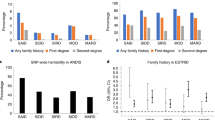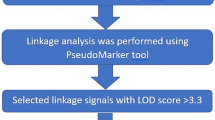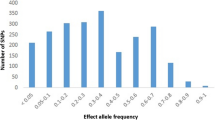Abstract
The objective of this study was to identify additional diabetes susceptibility markers in the MHC that could be responsible for the differential diabetogenicity of different HLA-DR3 CEHs. High-resolution SNP genotyping of the MHC was carried out in 15 type 1 diabetes (T1D) patients and 39 non-diabetic controls, homozygous for DR3-DQ2 and with one copy of the A*30-B*18-MICA*4-F1C30-DRB1*0301-DQB1*0201-DPB1*0202 HLA haplotype. Significantly associated SNPs were replicated in an independent sample of 554 T1D patients and 841 controls without HLA matching. Electrophoretic mobility shift assay was used to show a functional effect of an associated SNP. Seven SNPs showed evidence of association in the initial discovery experiment. Upon replication, only rs419434 (upstream HLA-DOA gene) remained significant. A functional variant (rs432375) in complete LD with rs419434 was shown to affect USF-1 binding and could be responsible for the association signal in the region. We have identified a new susceptibility locus within the MHC with a modest contribution to T1D (OR=1.93; CI: 1.52–2.44; P=10−8) that is independent of HLA-DRB1 locus.
This is a preview of subscription content, access via your institution
Access options
Subscribe to this journal
Receive 6 digital issues and online access to articles
$119.00 per year
only $19.83 per issue
Buy this article
- Purchase on Springer Link
- Instant access to full article PDF
Prices may be subject to local taxes which are calculated during checkout


Similar content being viewed by others
References
Johansson S, Lie BA, Todd JA, Pociot F, Nerup J, Cambon-Thomsen A et al. Evidence of at least two type 1 diabetes susceptibility genes distinct from HLA-DQB1, -DQA1 and -DRB1. Genes Immun 2003; 4: 46–53.
Nejentsev S, Gombos Z, Laine AP, Veijola R, Knip M, Simell O et al. Non-class II HLA gene associated with type 1 diabetes maps to the 240-kb region near HLA-B. Diabetes 2000; 49: 2217–2221.
Koeleman BV, De Groot KN, Van Der Slik AR, Roep BO, Giphart MJ . Association between D6S2223 and type 1 diabetes independent of HLA class II in Dutch families. Diabetologia 2002; 45: 598–599.
Yunis EJ, Larsen CE, Fernandez-Viña M, Awdeh ZL, Romero T, Hansen JA et al. Inheritable variable sizes of DNA stretches in the human MHC: conserved extended haplotypes and their fragments or blocks. Tissue antigens 2003; 62: 1–20.
Cambon-de Mouzon A, Ohayon E, Hauptmann G, Sevin A, Abbal M, Sommer E et al. HLA-A, B, C, DR antigens, Bf, C4 and glyoxalase I (GLO) polymorphisms in French Basques with insulin-dependent diabetes mellitus (IDDM). Tissue Antigens 1982; 19: 366–379.
Bilbao JR, Calvo B, Aransay AM, Martin-Pagola A, Perez de Nanclares G, Aly TA et al. Conserved extended haplotypes discriminate HLA-DR3-homozygous Basque patients with type 1 diabetes mellitus and celiac disease. Genes Immun 2006; 7: 550–554.
Nejentsev S, Howson JM, Walker NM, Szeszko J, Field SF, Stevens HE et al. Localization of type 1 diabetes susceptibility to the MHC class I genes HLA-B and HLA-A. Nature 2007; 45: 887–892.
Aly TA, Baschal EE, Jahromi MM, Fernando MS, Babu SR, Fingerlin TE et al. Analysis of single nucleotide polymorphisms identifies major type 1A diabetes locus telomeric of the major histocompatibility complex. Diabetes 2008; 57: 770–776.
Husain Z, Kelly MA, Eisenbarth GS, Pugliese A, Awdeh ZL, Larsen CE et al. The MHC type 1 diabetes susceptibility gene is centromeric to HLA-DQB1. J Autoimmun 2008; 30: 266–272.
Roach JC, Deutsch K, Li S, Siegel AF, Bekris LM, Einhaus DC et al. Genetic mapping at 3-kilobase resolution reveals inositol 1,4,5-triphosphate receptor 3 as a risk factor for type 1 diabetes in Sweden. Am J Hum Genet 2006; 79: 614–627.
Lie BA, Thorsby E . Several genes in the extended human MHC contribute to predisposition to autoimmune diseases. Curr Opin Immunol 2005; 17: 526–531.
Purcell S, Neale B, Todd-Brown K, Thomas L, Ferreira MAR, Bender D et al. PLINK: a toolset for whole-genome association and population-based linkage analysis. Am J Hum Genet 2007; 81: 559–575.
Qu HQ, Marchand L, Szymborski A, Grabs R, Polychronakos C . The association between type 1 diabetes and the ITPR3 gene polymorphism due to linkage disequilibrium with HLA class II. Genes Immun 2008; 9: 264–266.
Monsuur AJ, de Bakker PIW, Zhernakova A, Pinto D, Verduijn W, Romanos J et al. Effective detection of human leukocyte antigen risk alleles in celiac disease using tag single nucleotide polymorphisms. Plos One 2008; 3: 1–6.
Barker JM, Triolo TM, Aly TA, Baschal EE, Babu SR, Kretowski A et al. Two single nucleotide polymorphisms identify the highest-risk diabetes HLA genotype: potential for rapid screening. Diabetes 2008; 57: 3152–3155.
Barrett JC, Fry B, Maller J, Daly MJ . Haploview: analysis and visualization of LD and haplotype maps. Bioinformatics 2005; 21: 263–265.
Miretti MM, Walsh EC, Ke X, Delgado M, Griffiths M, Hunt S et al. A high-resolution linkage-disequilibrium map of the human major histocompatibility complex and first generation of tag single-nucleotide polymorphisms. Am J Hum Genet 2005; 76: 634–646.
Jeffreys AJ, May CA . Intense and highly localized gene conversion activity in human meiotic crossover hot spots. Nat Genet 2004; 36: 151–156.
Zavattari P, Deidda E, Whalen M, Lampis R, Mulargia A, Loddo M et al. Major factors influencing linkage disequilibrium by analysis of different chromosome regions in distinct populations: demography, chromosome recombination frequency and selection. Hum Mol Genet 2000; 9: 2947–2957.
Jeffreys AJ, Kauppi L, Neumann R . Intensely punctate meiotic recombination in the class II region of the major histocompatibility complex. Nat Genet 2001; 29: 217–222.
Prokunina L, Castillejo-López C, Oberg F, Gunnarsson I, Berg L, Magnusson V et al. A regulatory polymorphism in PDCD1 is associated with susceptibility to systemic lupus erythematosus in humans. Nat Genet 2002; 32: 666–669.
Tokuhiro S, Yamada R, Chang X, Suzuki A, Kochi Y, Sawada T et al. An intronic SNP in a RUNX1 binding site of SLC22A4, encoding an organic cation transporter, is associated with rheumatoid arthritis. Nat Genet 2003; 35: 341–348.
Fallas JL, Tobin HM, Lou O, Guo D, Sant’Angelo DB, Denzin LK . Ectopic expression of HLA-DO in mouse dendritic cells diminishes MHC class II antigen presentation. J Immunol 2004; 173: 1549–1560.
Acknowledgements
This work was partially funded by CIBER de Diabetes y Enfermedades metabólicas (CIBERDEM) and Research Project grants 05/2291 from Instituto de Salud Carlos III (LC) and 2005/111039 from the Basque Department of Health (AMA). IS and AC-R are predoctoral fellows supported by grants from the University of the Basque Country and the Spanish Ministry of Education, respectively. JRB is co-funded by the I3SNS Program of the Spanish Ministry of Health (CES05/036).
Author information
Authors and Affiliations
Corresponding authors
Additional information
Supplementary Information accompanies the paper on Genes and Immunity website (http://www.nature.com/gene)
Rights and permissions
About this article
Cite this article
Santin, I., Castellanos-Rubio, A., Aransay, A. et al. Exploring the diabetogenicity of the HLA-B18-DR3 CEH: independent association with T1D genetic risk close to HLA-DOA. Genes Immun 10, 596–600 (2009). https://doi.org/10.1038/gene.2009.41
Received:
Revised:
Accepted:
Published:
Issue Date:
DOI: https://doi.org/10.1038/gene.2009.41
Keywords
This article is cited by
-
What to do with HLA-DO/H-2O two decades later?
Immunogenetics (2019)
-
Conditional meta-analysis stratifying on detailed HLA genotypes identifies a novel type 1 diabetes locus around TCF19 in the MHC
Human Genetics (2011)
-
Novel Gene Associations in Type 1 Diabetes
Current Diabetes Reports (2010)



